11. Mar 2020 - DOI 10.25626/0110
Sabine Volk is a PhD candidate in Political Science at the Jagiellonian University in Kraków and an Early Stage Researcher (ESR) in the Marie Skłodowska-Curie Innovative Training Network 'FATIGUE', funded by the EU (Horizon2020). Her dissertation explores far-right populist politics of memory and the ritualization of counter-hegemonic protest in post-socialist eastern Germany. Prior to her PhD, Sabine obtained two Master’s Degrees in European Studies, one from the Universities of Groningen and Strasbourg and the other from the College of Europe, Natolin. She also studied at the Universities of Tübingen, Cádiz and Indianapolis.
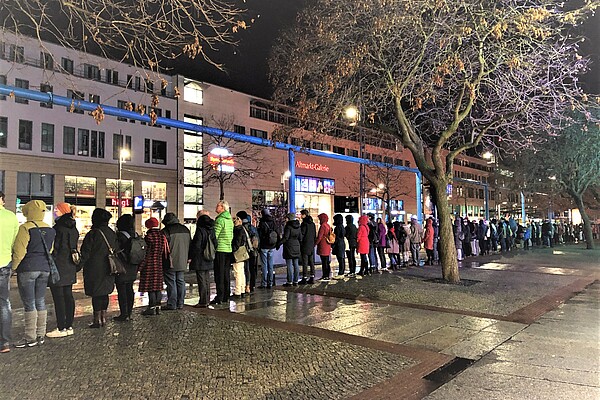
On the afternoon of 13 February 2020, the crowded Dresden city centre turned silent for exactly thirteen minutes. Thousands of people were standing side by side holding hands, while the bells of the city’s many churches were ringing. The next day, the local newspaper reported that 11,000 people had formed a human chain around Dresden’s city centre, ranging from the iconic squares of the historical district over the Elbe river to the shore of the trendy Neustadt. Somewhere amongst the citizens of Dresden, Germany’s president, Frank-Walter Steinmeier, had joined the human chain. His presence underscored the continued relevance of 13 February for the commemorative culture of Dresden, but also for Germany as a whole. Every year, Dresden and Germany commemorate the nearly complete destruction of the city centre and the neighbouring districts as well as the deaths of many thousands of people that resulted from one of the major Allied air attacks on Germany between 13 and 15 February 1945, in the final months of the Second World War. While the local population had hoped to stay relatively unharmed by the war due to Dresden’s international fame as a city of art and culture, the British and American forces dropped an outstandingly high number of bombs on the city within an extremely short time frame. The city’s picturesque centre with its many classicist and Baroque buildings was entirely destroyed in two major raids in spring 1945. The Red Cross reported 25,000 victims, 7,000 of which were burned on the old market square (Altmarkt) in Dresden’s city centre.
From the spring of 1945 onwards, Dresden quickly became one of the main symbols of German suffering and the horrors of warfare during the Second World War more broadly. Anniversaries of the destruction of the city were typically set up as major events gathering attention from national and international politics, media, and scholarship. Both the regime of the post-war German Democratic Republic (GDR) and that of reunited Germany after 1989 invested excessive sums in the historical reconstruction of some of the most iconic buildings in the city centre. For example, between 1945 and 1964 the Baroque-style Zwinger palace was rebuilt and between 1992 and 2005 the Frauenkirche was painstakingly reconstructed in its original form.
At the same time, 13 February remains one of Germany’s most contested remembrance days. It frequently triggers vast political and media debates about the legitimacy of remembering German victimhood given Nazi responsibility for starting the war and the Holocaust. In this context, political confrontation and both discursive and physical violence on the streets of Dresden are traditionally part of official commemoration practices. Hence, this year’s 75th anniversary of the destruction of Dresden was announced as a significant event; 13 February 2020 did not only succeed the 75th anniversary of the liberation of Auschwitz, which had been a major event in western memory cultures, but probably was also one of the last big anniversaries in which witnesses would be able to participate.
In the following contribution I will explore this year’s commemoration practices in Dresden, with a specific focus on the ongoing debate on the value and meaning of the date for the memory culture of both Dresden and Germany. After explaining the historical background of the ‘myth of Dresden’ and the emergence of the politics of memory in the city, I will map out its main public events and actors, narratives, and controversies. By contrasting the official discourse with the events taking place in the public space, I will show that contemporary politics of memory in Dresden are by far not as unified as city officials publicly declare. This contribution draws on ethnographic fieldwork which I conducted between September 2019 and February 2020, thus comprising a long period of time building up to the anniversary until a couple of weeks following the anniversary.
The strategic politics of memory and propaganda across both German dictatorships drew on the destruction of Dresden to create a unique myth of German wartime suffering.[1] Already in 1945, the weakened Nazi regime purported that the destruction of Dresden was the worst war crime of the entire Second World War. The myth portrayed Dresden as a city of art and culture with no military importance whatsoever, whose innocent population fell victim to the brutality of the Allied forces. The Nazi regime also lied about the number of victims of the bombing by adding an extra zero to the number established by the Red Cross, thus creating the myth of the 250,000 deaths during the Dresden bombing.
In the late 1940s, at the beginning of the Cold War, the state socialist regime in the fledgling GDR adapted the Nazi myth for its own purposes. It continued to promote the narrative of the destruction of Dresden as a war crime even worse than the dropping of the atomic bomb on the Japanese cities of Hiroshima and Nagasaki.[2] At the same time, the socialist regime twisted the myth, depicting Dresden as a symbol for the ideological inferiority of both ‘Allied imperialism’ and German fascism. The municipality impressively illustrated this reading of history when in 1965, it erected a memorial to the victims in Dresden’s largest cemetery, the Heidefriedhof.[3] In close proximity to the memorial, a rondel with fourteen steles was built. Seven of those steles carry names of destroyed cities, including Dresden, Warsaw, and Coventry, while seven opposite steles carry names of Nazi concentration and death camps such as Theresienstadt, Dachau, and Auschwitz. The memorial thus frames the destruction of Dresden and the genocide of the European Jews as two components of one single narrative of war victimhood.
Shortly after the fall of the Berlin Wall, the West German far right scene discovered Dresden as a stage on which to perform its revisionist political play.[4] Already in the months before the reunification of the two German states, West German neo-Nazis regularly gathered in Dresden.[5] The local population barely reacted. Appropriating the narrative of Dresden’s victimhood pushed by both the Nazi and the GDR regime, neo-Nazis started to organize regular large-scale ‘marches of grief’ on the occasion of 13 February, starting in 1999. By 2005, these marches had regularly attracted a couple thousand far right extremists from all over Germany and beyond. The photographs of Dresden’s spookily quiet protestors in black, with burning torches, marching through Dresden’s historically reconstructed city centre and passing the symbolic remnants of the Frauenkirche, travelled the world.
The stark increase in the number of demonstrators between 1999 and 2009 was also related to the lack of a coordinated civic response. Mostly due to the ideological differences amongst the political factions in the city council, political representatives, specifically the centre-right Christian Democrats (CDU) and the leftist successor of the GDR’s state socialist party – then the Partei des Demokratischen Sozialismus (Party of Democratic Socialism, PDS), today Die Linke(The Left) – were unable to decide on a common response to the instrumentalization of Dresden’s past. Hence, it was up to civil society to confront the regular neo-Nazi marches. Organizations such as Dresden Nazifrei – Dresden stellt sich quer (Nazi-free Dresden – Dresden resists) with connections into the militant radical left milieus emerged. Their protest lead to sometimes violent confrontations of the two opposing camps, with the police forces and city representatives somewhat helpless in-between.
While commemorative inactivity on the side of the city authorities marked the first decade after reunification, this started to change around the mid-2000s. In 2004, then mayor of Dresden, Ingolf Roßberg (FDP), initiated a commission of historians to research the many myths surrounding the wartime destruction of Dresden. Most importantly, the commission’s task was to establish certainty about the numbers of victims of the Allied attacks, as well as about the use of strafing, which is the military practice of deploying low-flying aircraft from which the population is shot at from a short distance. In its final report, published in 2010, the commission established that 25,000 people had fallen victim to the Allied attacks. It thus corrected the number of victims purported since the Nazi period, which had been ten times higher. Still, that higher numbers remain a reference point for today’s far-right politicians, among them representatives of the far-right Alternative for Germany (AfD), who regard them as still relevant. The report also showed that strafing had not been a part of the attack. Hence, the commission invalidated the myth of the destruction of Dresden as the deadliest attack of the Second World War.
In 2009, the new mayor Helma Orosz (CDU) initiated a working group tasked with designing a form of collective commemoration of the city’s destruction. Such a public event was supposed to do both, commemorate the war victims and pose a powerful statement against the neo-Nazi appropriation of Dresden’s past. Since then, AG 13. Februar (13 February Working group) has brought together representatives of all political factions in the city council as well as members of trade unions, the churches, and of various civic organizations engaged in history and remembrance. On the afternoon of 13 February 2010, the working group organized a human chain as a strong symbolic gesture against the neo-Nazis. The human chain, formed by thousands of locals and visitors, symbolically put a protective belt around the city centre, suggesting its impermeability to the perceived neo-Nazi threat. It has since become the most important practice during the official commemoration event each year.
Another important measure planned by the working group was the ‘decentralization’ of the established commemoration practices at the Heidefriedhof. The old memorial at Dresden’s largest cemetery, close to which the ashes of around 7,000 cremated victims had been buried in 1945, has traditionally been one of the centres of official commemorative acts – but also of the far right appropriation of the city’s past. Since 2016, civil society organizations such as the memory society Denk Mal Fort! (the name is a pun related to the German word for ‘monument’ and the verb ‘to think’) and the Dresdner Geschichtsverein (Dresden’s Historical Association) have coordinated the commemorative rituals at the cemetery. Without the presence of official city representatives and the strict protocol of former commemorative practice, they emblematically relieved the weight of official commemoration from the contested location.[6] In addition, the city of Dresden problematized the wartime destruction in local museums, most importantly, in the Militärgeschichtliche Museum (Museum of Military History), the architecture of which explicitly refers to the bombing. Yet, the museum narrates the attacks on Dresden in the context of the Second World War and the Holocaust, thus aiming to undermine the myth of Dresden’s uniqueness.
Despite all these efforts, 13 February has remained a contested date in Dresden’s memory culture and politics up until the present day. Due to both leftist counter-protests and official commemoration events, the number of far right demonstrators may have diminished, and the marches typically do not take place on 13 February itself anymore. Yet, the image of Dresden as the city which conceded to neo-Nazi ideology proves to be sticky. This image has been further consolidated over the past five years due to the lack of a coordinated civic response to yet another type of regular march: those organized by the far right Patriotic Europeans against the Islamization of the West (PEGIDA). Since 2014, PEGIDA organizers have used the symbolically loaded tradition of ‘Monday demonstrations’ – clearly linked to the memory of the demonstrations in 1989 which toppled the GDR regime – to express their outrage about liberal politics. Hence, Dresden also has become a showcase for scholarly literature on dark heritage, trauma, and painful memories more broadly. In a recent volume European Memory in Populism, Susannah Eckersley characterizes the commemorative practices in Dresden as a confrontation between the (far right) politics of fear which appropriate the past on the one hand and the (centre-right to left-wing) politics of shame and regret which seek to find appropriate ways of dealing with the past on the other.[7]
This year’s 13 February was again the topic that dominated Dresden’s official politics of memory, revealing the date’s outstanding relevance for the identity of the city. In the context of the 30th anniversaries of the East German ‘Peaceful Revolution’ last year and the German Reunification this coming autumn, as well as the 75th anniversaries of the liberation of Auschwitz and the end of the Second World War, no other anniversary has triggered as much local media coverage and public attention.
The official approach to the matter has been to demonstrate the unity of the city, solidarity across state borders, and the recognition of German guilt by using targeted public events. Supported by a broad civic alliance of political and civil society actors across party lines, different formats of official public commemoration events sought to underline the city’s unified rejection of the neo-Nazi appropriation of the past. Its main public demonstration found expression in the now traditional human chain. For the eleventh year in a row, around 11,000 people held hands surrounding the historical city centre. Shortly before, President Frank-Walter Steinmeier had publicly addressed the citizens from a large stage opposite the Frauenkircheon Neumarkt.[8] In a relaxed, peaceful, and familiar atmosphere created by the performance of local choirs, Steinmeier declared his admiration for the city of Dresden for coming to terms with its difficult past and painful memories. Subsequently, the Frauenkircheinvited the guests to take part in the ‘silent remembrance’ by arranging lit candles in a candle-shaped container near the church. In a similar vein, the city aimed to demonstrate its unity in the context of ‘decentralized commemoration’ at various cemeteries, most importantly at the Heidefriedhof, on the morning of 13 February. After a short, solemn address by the Denk Mal Fort!-Association, which was coordinated by a city councillor of the Liberal Democrats (FDP), volunteers read out the names of 4,000 victims of the attack. The organizers clearly expressed their distance from both Nazi and GDR narratives of the destruction of Dresden, stressing that the reading did not take place at the notorious memorial to the victims, but on the left side, which is the actual place where the victims’ ashes were interred.
The official approach to the commemoration events on 13 February 2020 also demonstrated the city’s international solidarity with other destroyed cities and victims of war atrocities, as well as the unrestricted recognition of German guilt. Indeed, according to the city’s website, this year’s remembrance began quite tellingly with the commemoration of the liberation of Auschwitz at the memorial at Münchnerplatz on 27 January, acknowledging the ongoing relevance of the Holocaust for German post-reunification politics of memory. In line with this, PresidentSteinmeier campaigned in his speech on Neumarkt for a democratic and humble memory of the destruction of Dresden, putting the suffering of Dresden in the context of the suffering which Nazi Germany inflicted on Europe and the world. Suggesting that “the destruction of Dresden did not start in 1945, but in 1933”, he emphasized Germany’s own responsibility for the destruction of cities and suffering of its population.
The international dimension was ever-present during the public events organized in 2020. Foreign guests were invited, including representatives from Dresden’s many partner cities. Thus, the former mayor of Wrocław spoke in the Albertinummuseum and the current mayor of Coventry in the Frauenkirche. Most prominently, the Konrad Adenauer Foundation’s international conference on 14–15 February dealt with ‘painful memories’ (schmerzhafte Erinnerung)across international borders, inviting locals to discuss with international researchers, politicians, and media representatives from all continents. The conference commenced with a short video address by the current mayor of Hiroshima, once more establishing Dresden as an international location for the debate on how to deal with difficult pasts and painful memories. Finally, Dresden expressed its international solidarity through the prominent display of sculptures by the Danish-Norwegian artist Marit Benthe Norheim. The Rolling Angels, a mobile ensemble of seventeen guardian angels arranged in front of the Kulturpalastnext to Altmarkt, aimed to express the city’s support and care for victims of violence around the world.
Even though the weather forecast for 13 February 2020 was supposed to bring rain and wind in the afternoon, the storms, at least figuratively speaking, already arose in the morning – during the commemoration ceremony at the Heidefriedhof. This remained the dominant political climate throughout the whole week of remembrance. Political and civil society organizations from across the political spectrum actively interfered with each other’s commemoration events, causing the authorities to deploy hundreds of police officers, and thus marking the week as a period of public political contestation and counter-protest. Thus, the public declaration of unity was, at times, mere lip service.
Unsurprisingly, far right actors such as the local factions of the AfD and the neo-Nazi National Democratic Party (NPD) rejected official plans and set up their own commemoration events. Campaigning for a “dignified commemoration” of the German victims of the Allied attack, the AfD appropriated the memorial to the victims burned on Altmarkt throughout the day and evening of 13 February. The party staged its main commemoration act in a highly symbolic manner exactly between 9.45 and 10 pm, when the ringing of the church bells referred to the time of the first attacks on Dresden.
Based on a similar narrative of German victimhood and the rejection of German guilt, the NPD mobilized participants for the annual neo-Nazi ‘march of grief’ on the weekend after 13 February, ensuring that participants from abroad would be able to join. Around 1,200 participants, mostly in black, quietly marched and listened to speeches for around three hours. Their banners read, for instance, “Allied liberation = Holocaust against the German people”, while their flags showed the national symbols of Germany, France, Sweden, Hungary, amongst others. Even though the organizers had registered a march leading through the picturesque city centre, probably hoping for impressive mediatized images, they had to spontaneously change their route due to massive counter-demonstrations. The large-scale counter-protests blocked the original route by staging sit in protests, and around 3,000 protestors expressed their objection to the ‘march of grief’ by whistling and screaming. The presence of 1,500 deployed police officers, uncountable police vans, and a couple of horses, further demonstrated the perceived state of emergency that afternoon.
Yet, divisions were not only restricted to far right commemoration activities. For instance, representatives of Die Linke and the Greens did not join the commemoration ceremony at the Heidefriedhof, arguing that the reading of the names of victims contributed to the narrative of German victimhood. In turn, representatives of Die Linke had been involved in the tenth annual ‘march on the traces of the perpetrators’ (Mahngang Täterspuren) on the weekend before. The march highlighted Dresden’s guilt in the context of the Holocaust by tracing a selection of Nazi crimes committed in the city. On top of that, the youth organization of Die Linke actively disturbed the event at the Heidefriedhof. When the first names of German victims were read, recordings of the words “Perpetrators are not victims. We claim: abolish the commemoration. We commemorate the victims of German barbarianism!” sounded in a loop from phones and loudspeakers in the backpacks of young leftist activists. Much to the annoyance of the organizers of the event, the leftist protestors also unreeled banners and chanted slogans such as “Granny, gramps, and Hans-Peter – not victims, but perpetrators”. Later that day, leftist counter-protestors further disturbed official events with fireworks, such as the human chain, interrupting the devout silence between AltmarktandNeumarkt.
Based on the author’s own fieldwork experience in Dresden before, during, and after 13 February 2020, it seems fair to claim that the political controversies related to the day of commemoration are not restricted to this anniversary or even 13 February alone. Rather, there is recurrent confrontation between opposing camps on matters of memory, and the city struggles to give an adequate answer to far right threats to the democratic community. This is not in the least expressed every other Monday. Indeed, PEGIDA’s ‘evening strolls’ regularly involve discursive and, occasionally, physical violence, noisy leftist counter-protests, and the immense presence of police forces. They reveal the city’s inability to join forces against the far right appropriation of the city space and the heritage of 1989. The city only mobilized large-scale civic counter-protests when the prominent AfD politician Björn Höcke, a particularly extreme representative of the party, was the guest speaker at a PEGIDA demonstration only a couple of days after 13 February 2020.
After the city recovered from the perceived state of emergency this year, the question of the future of 13 February persists. How much memory of its destruction does the city need, and in which form? To some extent, Dresden seems to be a good showcase for Nietzsche’s famous claim that “the past needs to be forgotten if it is not to become the gravedigger of the present”.[9] Indeed, the continuous and occasionally obsessive dwelling on the past seems to paralyze the city’s politics and civil society alike. Therefore, one of the most poignant public events in the context of 13 February 2020 was associated with students of the local art academy. Their gilded obelisk, erected in the centre of Neumarktin the afternoon of 13 February, mocked Dresden as the “world champion in commemoration”. Undoubtedly, Dresden will continue to assume this role in the years to come. Given the dimensions of the atrocities committed by Nazi Germany in the context of the Holocaust and the Second World War, it might be a viable option to make the anniversaries of the liberation of Auschwitz on 27 January or the end of the Second World War on 8 May the core dates of Dresden’s future memory culture.
This research is part of a project that has received funding from the European Union’s Horizon 2020 research and innovation programme under grant agreement No. 765224.
Sabine Volk: Commemoration at the Extremes: A Field Report from Dresden 2020. In: Cultures of History Forum (11.03.2020), DOI: 10.25626/0110.
Copyright (c) 2020 by Imre Kertész Kolleg, all rights reserved. This work may be copied and redistributed for non-commercial, educational purposes, if permission is granted by the copyright holders. For permission please contact the editors.

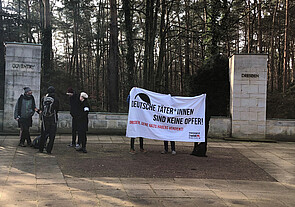
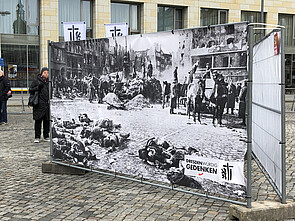
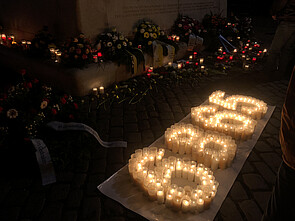
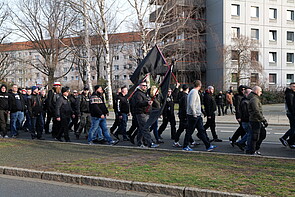
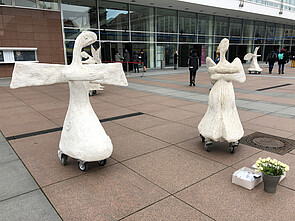
Hans Gutbrod · 30.05.2023
Sebald's Path in Wertach -- Commemorating the Commemorator
Read more
Matěj Spurný · 31.10.2021
The Colour of Compromise: The 'Documentation Centre for Displacement, Expulsion, Reconciliation' as ...
Read more
James Krapfl and Andrew Kloiber · 28.05.2020
The Revolution Continues: Memories of 1989 and the Defence of Democracy in Germany, the Czech Republ...
Read more
Gespräch · 30.11.2019
"In Auschwitz hat sich die Wirklichkeit entlarvt" - ein Gespräch mit Daniel Kehlmann
Read more
Gespräch · 17.05.2019
Revisiting the TV-Series “Holocaust” Thirty Years On
Read more
Get this article as PDF download (including pictures).